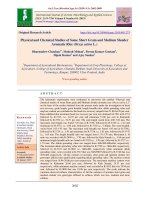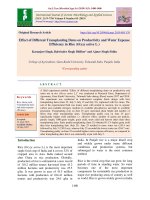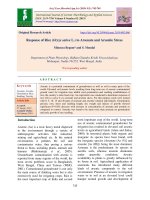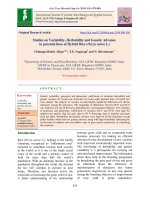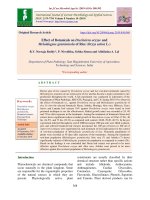Assessment of nutrient deficiencies based on response of rice (Oryza sativa L.) to nutrient omission in inceptisols of Kondagaon district of Chhattisgarh in India
Bạn đang xem bản rút gọn của tài liệu. Xem và tải ngay bản đầy đủ của tài liệu tại đây (249.13 KB, 10 trang )
Int.J.Curr.Microbiol.App.Sci (2018) 7(9): 350-359
International Journal of Current Microbiology and Applied Sciences
ISSN: 2319-7706 Volume 7 Number 09 (2018)
Journal homepage:
Original Research Article
/>
Assessment of Nutrient Deficiencies Based on Response of Rice
(Oryza sativa L.) to Nutrient Omission in Inceptisols of
Kondagaon District of Chhattisgarh in India
Balwant Kumar1, G.K. Sharma1*, V.N. Mishra2, A. Pradhan1 and T. Chandrakar1
1
Shaheed Gundadhur College of Agriculture and Research Station, Jagdalpur - 494 005
(Chhattisgarh), India
2
Department of Soil Science and Agricultural Chemistry, College of Agriculture,
Raipur - 492 012 (Chhattisgarh), India
*Corresponding author
ABSTRACT
Keywords
Yield limiting nutrients,
Site specific nutrient
management, Nutrient
omission technique,
Optimum nutrient doses
Article Info
Accepted:
04 August 2018
Available Online:
10 September 2018
The investigation was carried out at Shaheed Gundadhur College of Agriculture and
Research Station, Jagdalpur with the objectives to identify the specific yield limiting
nutrients through response of rice to nutrient omission in pot culture during kharif season,
2017 and to demonstrate the optimum use of identified limiting nutrients at field level in
wheat crop during rabi season 2017-18. The soil was a sandy clay loam, had a slightly
acidic soil reaction (pH 6.2), normal electrical conductivity, medium organic C and
available K, low available N, P, and S, high available Ca, Mg, Fe, Mn and Cu and
marginal available Zn and B. The experiment was laid out under completely randomized
design with 3 replications and 11 treatments, formulated by keeping one treatment with
application of all nutrients in optimum level and others by sequentially omitting each
nutrient. Omission of N and P nutrients significantly reduced the different growth, yield
and nutrients uptake parameters of rice in comparison to all nutrients. The maximum grain
yield of 67.1 g pot-1 was recorded, in all nutrients pot and 40.8 % reduction in grain yield
of rice, from the maximum yield, was recorded in N omitted pots, followed by 23.7 %
reduction in P omitted pots and omission of other nutrients didn’t reduce the grain yield
significantly indicating that only N and P were yield limiting nutrients. In field verification
during rabi season, 17.8 % increase in wheat grain yield and 20.9 % increase in net return
was recorded, due to optimum dose of identified yield limiting nutrients over farmer's
practice dose.
Introduction
Adequate supply of plant nutrients decides
optimum productivity of any cropping system.
Even if, all other factors of crop production
are in the optimum, the fertility of a soil
largely determines the ultimate yield (Sekhon
and Velayutham, 2002). When the soil does
not supply sufficient nutrients for normal plant
development and optimum productivity,
application of supplemental nutrients is
required. Fertilizer is one of the most
important sources to meet this requirement.
Indiscriminate use of fertilizers, however, may
350
Int.J.Curr.Microbiol.App.Sci (2018) 7(9): 350-359
cause adverse effect on soils and crops both
regarding nutrient toxicity and deficiency
either by over use or inadequate use (Ray et
al., 2000). Soil fertility evaluation, thus, is the
key factor for adequate and balanced
fertilization of crops in high crop production
systems. Soil and plant analyses are
commonly performed to assess the fertility
status of a soil with other diagnostic
techniques
including
identification
of
deficiency symptoms and biological tests
which are helpful in determining specific
nutrient stresses and quantity of nutrients
needed to optimize the yield (Havlin et al.,
2007). However, the analytical results do not
indicate the most limiting nutrient according
to Liebig's law of the minimum “the minimum
nutrient is the factor that governs and controls
growth and potential yield of crop”.
A nutrients omission trial aims to find out the
most limiting nutrients to the growth of a crop
plant. If any element is omitted while other
elements are applied at suitable rates and
plants grow weakly, then the tested element is
a limiting factor for crop growth. Conversely,
if any element is omitted but plants are
healthy, then that element is not a limiting
factor for crop production. Conducting
fertilizer field trials is an expensive task and
time consuming process. This information can
be generated through pot culture trial in
controlled conditions through laboratory and
greenhouses studies. This situation calls to
identify the yield limiting nutrients for
correcting the deficiencies and boosting the
crop yield.
Rice (Oryza sativa), is an important staple
food of India and continues to play a vital role
in the national food and livelihood security
system. India is having largest area under rice
crop. However, productivity is lower than
world’s average productivity. The reason for
low productivity is that rice is being grown in
the country under various agro-ecologies in
both irrigated and rainfed systems. States like
Uttar Pradesh, Bihar, West Bengal, Orissa,
Jharkhand, Chhattisgarh and Assam are
having huge potential for rice cultivation and
there is scope to increase productivity in this
region.
The deficiency of some micro and secondary
nutrients is one of the major causes for
stagnation in crop productivity. Exploitive
nature of modern agriculture involving use of
high analysis NPK fertilizers, free from
micronutrients as impurities, limited use of
organic manures and restricted recycling of
crop residues are some important factors
having contributed towards accelerated
exhaustion of secondary and micronutrients
from soil. At several places, normal yield of
crops could not be achieved despite balanced
use of NPK due to micronutrient deficiency in
soils (Sakal, 2001).
Chhattisgarh State has four major soils type
i.e. Entisols, Inceptisols, Alfisols and Vertisols.
Almost all soils are deficient in nitrogen and
phosphorus and medium to high in potassium.
Zinc deficiency is also reported in some
patches of Alfisols and Vertisols of this region.
In view of continuous use of sulfur free
complex fertilizers, chances of increase in S
deficiency are likely. In addition to this
limitation,
low
fertilizer
efficiency,
inadequacy
of
current
fertilizer
recommendations and the ignorance of
nutrients other than N, P, and K may limit
crop production. In view of continuous use of
high analysis fertilizer, multiple nutrient
deficiencies are likely. High crop yields can
only be achieved by correcting such
deficiencies.
Site
specific
nutrient
management is of utmost importance for
obtaining high yields on sustainable basis
(Sahu et al., 2017). However, little is known
about the sustainability of the current
production systems, particularly systems with
multiple cropping under minimum practice.
351
Int.J.Curr.Microbiol.App.Sci (2018) 7(9): 350-359
Looking to very limited information on the
proper and site specific nutrient doses to
maximize yield of rice, present investigation
was undertaken with the objective to assess
the yield limiting nutrients based on rice
response to nutrient omission and to
demonstrate the optimum use of identified
limiting nutrients and its comparison with
farmer’s fertilizer practice.
Materials and Methods
Location of the study
Apot culture investigation was undertaken
with the objectives to identify the specific
yield limiting nutrients through response of
rice (MTU-1001) to nutrient omission in
Inceptisols of Kondagaon district, during the
kharif season 2017 at the green house of
Section of Soil Science and Agricultural
Chemistry,Shaheed Gundadhoor College of
Agriculture and Research Station, Jagdalpur,
Bastar (Chhattisgarh) and subsequently a
demonstration at farmers field at village –
Badebendri, block and district – Kondagaon to
demonstrate the optimum use of identified
limiting nutrients in wheat (GW-273) during
rabi season 2017-18.The study site lies at
19010’ N latitude and 81095 E longitude with
an altitude of 550-760 meter above the mean
sea level.
Initial characteristics of the experimental
soils
The Inceptisols, locally called Matasi, are
immature soil with poor soil profile features
having lighter texture and shallow to moderate
depth. Soils are being used exclusive for
growing early rice after bunding, puddling and
leveling and for pulses and maize without
bunding. They are soft and non-sticky when
wet, easily workable under wet cultivation for
puddling and biasi operation and therefore,
can easily be managed to improve surface
water retention for rice cultivation. Under this
order the dominating sub-group is typic
haplustept and Vertic haplustept. Vertic
haplustept have clayey texture with clay
content varying from 48.0 to 55.0%. Typic
haplustept is sandy clay loam to clay loam in
texture with clay content raining from to 33.2
to 50.4%. The initial physicochemical
characteristics of the experimental soil
(Inceptisol) were determined (Table 1) using
common field and laboratory procedures. The
experimental soil was a sandy clay loam, had
a slightly acidic soil reaction (pH 6.2), normal
electrical conductivity, medium organic C and
available K, low available N, P, and S, high
available Ca, Mg, Fe, Mn and Cu and
marginal available Zn and B (Table 1).
Experimental plan
The experiment was laid out under completely
randomized design with 3 replications and 11
treatments, formulated by keeping one
treatment with application of all nutrients in
optimum level and others by sequentially
omitting each nutrient. Bulk soil samples
representative of Inceptisols of the district was
collected from the farmer's fields for pot
culture experiment. The processed and
uniformed soil samples were filled in plastic
pots @ 20 kg and nutrients as specified above
were applied through different sources taking
care to avoid any precipitation during solution
mixing and application. The optimum doses of
nutrients were fixed in kg ha-1 as N -150, P2O5
- 100, K2O - 100, S - 45, Ca - 110, Mg - 50, Fe
- 20, Mn - 7.5, Cu - 7.5, Zn -7.5, B - 3 and Mo
- 0.75 for SSNM dose. Rice (MTU-1001) was
taken as test crop. The pots were maintained
saturation with standing water and twenty five
days old seedlings of rice (MTU-1001) were
transplanted on 22th July 2017. Three
seedlings of MTU-1001 variety of rice were
planted in three hills in each pot and water
level was maintained at 3 cm throughout the
crop season. Thereafter, full dose of all the
352
Int.J.Curr.Microbiol.App.Sci (2018) 7(9): 350-359
nutrients except nitrogen was added to the soil
in solution form. Nitrogen as urea was applied
in three splits at transplanting, tillering and
panicle initiation stage. Crop was grown till
maturity and harvested on 17th November,
2017. The effects of treatments were recorded
in terms of yield, different yield attributing
parameters and nutrient uptake by rice crop.
Based on these results, N and P nutrients were
identified as yield limiting nutrients. The
optimum use of limiting nutrients was
demonstrated at farmer's field, from where the
bulk soil was collected, with wheat variety
GW-273 as a test crop during rabi season
2017-18.The wheat crop was sown on 14th
Dec 2017 and harvested on 14th April 2018.
The farmer's used fertilizer dose at the rate of
80 kgN: 50kgP2O5: 30 kg K2O ha-1. The
effects of optimum/SSNM dose was compared
with farmer's fertilizer practice.
nutrients (Table 2). Omission of other
nutrients didn’t reduce the number of tillers
pot-1 significantly. N plays a key role in tillers
bearing of rice followed by P. On an average,
21.3 tillers pot-1was observed, at 60 DAT,
with treatment that received all nutrients and
various nutrients omission treatments had
reduced number of tillers. Omission of N and
P reduced the number of tillers significantly as
these two nutrients have major role in tillers
bearing of the crop. Many researchers have
also concluded the importance of N and P in
tillering of rice (Singh, 2008, Sahu et al.,
2017).
Number of effective tillers pot-1
Results and Discussion
Omission of N and P nutrients significantly
reduced the effective tillerspot-1of rice as
compared to treatment that received all
nutrients. Other nutrients omission didn’t
reduce the effective tillers pot-1 of rice.
Growth and yield attributes of rice
Number of filled grains panicle-1
Plant height
Similar trend was also observed for number of
filled grains per panicle of rice which varied
from 112.3 to 142.0. The treatments missing N
and P nutrients recorded significantly reduced
number of filled grains per panicle as
compared to treatment which received all
nutrients (Table 2).
Omission of nutrients had a significant effect
on plant height of rice crop (Table 2). Plant
height is one of the most important
characteristics which indicate nutrients
absorption capacity as well as health of the
soil and plant. The highest plant height of rice
was recorded under treatment where all the
nutrients were supplied, whereas significantly
lower plant height was recorded under the
treatments missing N, and P nutrients.
Number of tillers pot-1
Significantly higher number of tillers pot-1,
recorded at 60 days after transplanting of rice,
was observed in treatment that received all
nutrients and on the other hand, omission of N
and P nutrients significantly reduced the
number of tillers pot-1in comparison to all
Test weight
A close examination of the data pertaining to
test weight (1000 grain weight) presented in
Table 2 showed that the test weight of rice
grain didn’t varied significantly with different
treatments. In general, the test weight of rice
grain varied from 25.2 to 26.0g per1000
grains.However, omission of N and P pots had
reduced the test weight as compared to those
of all other treatments. It is universally truth
that N and P are the most important major
nutrients require for tillering, root growth and
353
Int.J.Curr.Microbiol.App.Sci (2018) 7(9): 350-359
general plant vigor that affect ultimately filled
grains and test weight. The reduced effective
tillers, number of filled grains per panicle and
test weight were recorded in present study
because of omission of N and P nutrients.
Since N is an important constituent of amino
acids, proteins and protoplast, its application
had a more pronounced effect on plant growth
and development through better utilization of
photo-synthates and more vegetative growth.
These results are in conformity of the findings
of Singh, (2008) and Sharma et al., (2000). P
omission had also exhibited a significant
effect on plant height. Optimum P availability
is essential for normal growth and
development and the utilization of other
nutrients, particularly N. The significant crop
response to P application was also reported by
many workers (Ahmed et al., 2010 and Mc
Beath et al., 2007).
Yield of rice
Grain yield
The maximum grain yield (67.1 g pot-1) was
recorded under the treatment receiving all the
nutrients and that of the lowest grain yields
(39.7 g pot-1) was recorded under omission of
N followed by omission of P (51.2 g pot-1)
nutrients. Omission of N and P nutrients
significantly reduced the grain yield of rice in
comparison to the treatment that received all
nutrients. In other treatments, grain yields
were observed statistically at par in
comparison to treatment where all the
nutrients were supplied to rice crop (Table 2).
Grain yield reduction
The reduction of rice grain yield because of
omission of different plant nutrients, from
treatment that received all nutrients, wasalso
worked out (Table 2). The yield limiting
nutrients which reduced the yield by about
10% from the maximum yield obtained by
treatment receiving all nutrients, was critically
observed. It was noticed that omission of N
reduced the grain yield of rice by 40.8 % and
P omission caused a reduction of 23.7 % in
grain yield of rice. Large reductions in the
grain yield of rice were observed with the
omission of N and P as compared to the other
nutrient omission treatments. The yield
reductions were more pronounced with N
omission. Result clearly indicates that N is the
most critical nutrients that affect the grain
yield considerably followed by P. Omission of
all other nutrients did not indicate yield
reduction.
Straw yield
It is evident from the data in Table 2 that the
mean straw yields of rice were significantly
affected with imposition of different nutrient
omission treatments. Omission of N and P
significantly reduced the straw yield as
compared to treatment where all the nutrients
were supplied. The highest straw yield (83.0 g
pot-1) of rice was observed in treatment that
omit Ca which was at par with treatment
where all the nutrients were applied and
lowest (50.8 pot-1) in treatment where N was
omitted followed by P omission treatment.
Primary nutrient uptake
N uptake
The data in Table 3 indicated that the nitrogen
uptake by rice was significantly affected with
application of different missing nutrient
treatments. Omission of N and P significantly
reduced the N uptake by rice as compared to
treatment where all the nutrients were
supplied. The highest N uptake of 1.12 g pot-1
was recorded in the treatment that received all
the nutrients and that of the lowest N uptake
of 0.65 g pot-1 was recorded in the pots where
N was omitted. Supply of all the nutrients
354
Int.J.Curr.Microbiol.App.Sci (2018) 7(9): 350-359
including nitrogen in “All” treatment
increased the grain and straw yields as well as
the nitrogen concentrations causing more
uptake of N (Syed et al., 2006). Minimum
nitrogen uptake was observed with nitrogen
omission because nitrogen was the most yield
limiting nutrient which resulted in lower
yields and lower nitrogen uptake. The similar
findings were also reported by Mishra et al.,
(2007).
similar reductions in P concentration with
omission of P have also been reported by Din
et al., (2001) for chickpea. Supply of P in
“All” treatment increased the soil solution P
causing higher absorption of P resulting in
higher grain and straw yields as well more
uptake of P because P was the next most yield
limiting nutrient after N, which resulted in
lower yields and lower P concentrations.
Potassium uptake
Phosphorus uptake
The highest total uptake of P by rice was
recorded to the tune of 0.26 g pot-1 under the
treatment where all the nutrients were applied.
Whereas the lowest total P uptake (0.15g
pot-1) was observed in the treatment that
missed N. Reductions in P uptake with
omission of N and P have also been reported
by Mishra et al., (2007) for rice crop and
The highest K uptake (1.37 g pot-1) was
observed in the treatment that received all the
nutrients and Ca omitted pots and the lowest K
uptake (0.83 g pot-1) were registered in the N
omission treatment followed by P omission
treatment. Omission of N and P nutrients
significantly reduced the K uptake by rice in
comparison to treatment that received all
nutrients.
Table.1 Initial physicochemical characteristics of experimental soils
S. No.
1.
2.
3.
4.
5.
6.
7.
8.
9.
10.
11.
12.
13.
14.
15.
Soil Characteristics
Mechanical Analysis
Sand (%)
Silt (%)
Clay (%)
pH (1:2.5 soil: water suspension)
Electrical Conductivity (dS m-1)
Organic C (%)
N Available (kg ha-1)
P Available (kg ha-1)
K Available (kg ha-1)
S Available (kg ha-1)
Ca Available (kg ha-1)
Mg Available (kg ha-1)
Fe Available (mg kg-1)
Mn Available (mg kg-1)
Zn Available (mg kg-1)
Cu Available (mg kg-1)
B Available (mg kg-1)
355
Value
Rating
55
24
21
6.2
0.14
0.55
247
10.0
158
18.4
1040
496
60.36
21.91
0.97
1.14
0.53
Sandy clay loam
Slightly acidic
Normal
Medium
Low
Low
Medium
Low
High
High
High
High
Marginal
High
Marginal
Int.J.Curr.Microbiol.App.Sci (2018) 7(9): 350-359
Table.2 Effect of nutrient omission on yield and yield attributes of rice (MTU-1001) in Inceptisol of Kondagaon district of
Chhattisgarh
Treatments
All
All-N
All-P
All-K
All-S
All-Ca
All-Mg
All-Cu
All-Zn
All-B
All-Mo
SEm (±)
CD at 5% level
Plant height
(cm)
99.6
85.4
93.3
99.0
96.4
99.5
98.4
99.4
98.1
97.6
97.5
1.02
3.03
Tillers (No. pot1
)
21.3
16.7
18.7
20.7
20.3
21.0
20.3
20.7
20.7
20.7
20.7
0.65
1.94
Effective tillers
(No. pot-1)
18.3
13.7
15.7
17.7
18.0
18.0
18.0
18.3
18.0
17.3
17.3
0.80
2.39
Filled grains
(No. panicle -1)
142.0
112.3
118.7
140.0
129.0
137.0
136.7
138.0
136.0
138.3
141.3
5.77
17.13
Test weight (g
1000 grains-1)
26.0
25.2
25.6
26.0
25.9
25.9
25.9
25.9
25.9
25.9
25.9
0.24
NS
Grain yield (g
pot-1)
67.1
39.7
51.2
64.0
61.0
65.0
63.5
65.4
63.2
62.8
62.4
2.40
7.13
Grain yield
reduction (%)
40.8
23.7
4.6
9.1
3.1
5.4
2.5
5.8
6.4
7.0
-
Straw yield (g
pot-1)
82.5
50.8
63.9
80.8
76.5
83.0
80.9
81.0
78.4
77.5
79.6
3.02
8.97
Table.3 Effect of nutrient omission on total uptake of nutrients by rice (MTU-1001) in Inceptisol of Kondagaon district of
Chhattisgarh
Treatments
All
All - N
All - P
All - K
All - S
All - Ca
All - Mg
All - Cu
All - Zn
All - Bo
All - Mo
SEm±
CD at 5%
level
Primary Nutrients(g pot-1)
N
P
K
1.12
0.26
1.37
0.65
0.15
0.83
0.85
0.17
1.05
1.07
0.24
1.27
1.02
0.23
1.26
1.09
0.25
1.37
1.06
0.24
1.33
1.08
0.24
1.35
1.04
0.24
1.31
1.04
0.23
1.28
1.04
0.23
1.31
0.045
0.012
0.056
21.4
30.7
4.3
Secondary Nutrients(g pot-1)
Ca
Mg
S
0.69
0.40
0.18
0.41
0.23
0.10
0.52
0.30
0.13
0.66
0.37
0.17
0.62
0.36
0.17
0.63
0.38
0.18
0.66
0.36
0.17
0.66
0.37
0.17
0.65
0.36
0.17
0.63
0.36
0.17
0.64
0.37
0.17
0.029
0.016
0.004
0.90
1.20
21.4
356
Fe
21.4
12.6
16.3
20.5
19.7
21.1
20.6
20.8
20.4
20.7
20.2
1.00
2.95
Micronutrients(mg pot-1)
Mn
Zn
Cu
30.7
4.3
0.90
17.8
2.6
0.53
23.0
3.3
0.68
29.0
4.0
0.86
26.5
3.9
0.83
29.5
4.1
0.87
29.1
4.1
0.86
29.6
4.1
0.87
27.8
4.0
0.85
27.4
3.8
0.84
28.6
3.9
0.85
1.54
0.22
0.04
4.53
0.64
0.11
B
1.20
0.73
0.93
1.17
1.11
1.18
1.15
1.18
1.14
1.13
1.14
0.04
0.13
Int.J.Curr.Microbiol.App.Sci (2018) 7(9): 350-359
Table.4 Grain yield and economics of wheat in relation to SSNM and Farmer’s fertilizer dose in
Inceptisol of Kondagaon district
S. No. Nutrient
Dose
SSNM
1
FFD
2
Difference
% Change
Yield (q Cost of cultivation Gross return Net return (Rs. B:C ratio (Rs.
ha-1)
(Rs. ha-1)
(Rs. ha-1)
ha-1)
Re-1)
28.4
32214
56800
24586
1.76
24.1
27869
48200
20331
1.73
4.3
4345
8600
4255
0.03
17.8
15.6
17.8
20.9
1.9
treatments in comparison to all nutrients
which might be due to higher initial Mg
content in soil. Uptakes of Mg in N and P
omitted pots were in the order of N < P in
accordance with the grain and straw yields
and Mg concentrations in the respective pots.
Secondary Nutrients uptake
Calcium uptake
The highest Ca uptake (0.69g pot-1) by rice
crop was observed in treatment that received
all the nutrients. Omission of N and P
nutrients significantly reduced the Ca uptake
in comparison to the maximum, and the least
uptake was observed in N omission (0.41g
pot-1) followed by P omission (0.52 g pot-1)
pots. Omission of N and P reduced the
uptakes more than that of omission of other
nutrients indicating that these two nutrients
were the most limiting nutrients. Lower Ca
uptakes were observed with N and P omission
obviously due to lower grain and straw yields
and lower Ca concentrations. Uptakes of Ca
in N and P omitted pots were in the order of N
< P in accordance with the grain and straw
yields and Ca concentrations in the respective
pots.
Sulphur uptake
The highest S uptake (0.18 g pot-1) was
recorded in treatment which received all
nutrients and the least total uptake of S was
observed in the treatment that omit N nutrient.
Omission of N and P caused significantly
reduced uptake of S, in comparison to
treatment that received all the nutrients.
Micronutrients uptake by rice
Fe uptake
The highest Fe uptake (21.4 mg pot-1) was
associated with the treatment receiving all the
nutrients, closely followed by omission of Ca,
Cu, B, Mg, K, Zn, Mo, and S respectively and
were statistically at par with each other and
significantly higher than Fe uptake in N and P
omission treatments. The lowest Fe uptake
(12.6 mg pot-1) was recorded in N omission
treatment followed by P (16.3 mg pot-1)
omission treatment.
Magnesium uptake
The highest total uptake of Mg was observed
with the treatment receiving all the nutrients
(0.40 g pot-1) because supply of all the
nutrients including Mg in All treatments
increased the grain and straw yields as well as
the Mg concentrations causing more uptakes
of Mg. Whereas, the least Mg uptakes (0.23
and 0.30 g pot-1) was observed with N and P
omission since these elements were the most
yield limiting in the soil. Mg uptakes were
found almost similar in all the other
Mn uptake
The significant reduction in uptake of Mn was
observed in N and P omission treatments than
357
Int.J.Curr.Microbiol.App.Sci (2018) 7(9): 350-359
the uptake observed with treatment receiving
all nutrients. The total uptake of Mn was
found maximum (30.7mg pot-1) in the
treatment where all the nutrients was applied
which was statistically at par with other
treatments except N and P. The least Mn
uptake (17.8 mg pot-1) was recorded in the
treatment where N was omitted followed by P
(13.0 mg pot-1) omission treatment.
that with the treatment receiving all the
nutrients.
Field verification of identified yield limiting
nutrients
Based on the response of rice crop to nutrients
omission, the yield limiting nutrients
identified was N and P. They were verified in
a verification trial at farmers field, from
where the bulk soil was collected for pot
experiment,
through
applying
optimum/SSNM dose of these nutrients in
wheat during rabi season 2017-18. The final
grain yields of wheat at farmer's fields under
both the doses were recorded and the
comparison is presented in Table 4. The
wheat grain yields at farmer's fields was
higher in SSNM dose applied, based on yield
limiting nutrients, as compared to that of
farmer's practice dose. The economic analysis
of both the fertilizer doses revealed that the
SSNM dose had higher gross return, net
return and B: C ratio as compared to farmers
practice dose, thus, it confirmed that N and P
was the yield limiting nutrients and the SSNM
dose was economically profitable to the
farmers.
Zinc uptake
Total uptake of Zn (4.3 mg pot-1) by rice was
found maximum in the treatment receiving all
the nutrients and minimum (2.6 mg pot-1) in
the treatment where N was omitted.
Significantly reduced Zn uptake was observed
with omission of N and P as compared to
treatment receiving all the nutrients and
uptake in other treatments was found at par
with it.
Cu uptake
The significant reduction in uptake of Cu
(0.53 mg pot-1) was found in N omission pot
followed by P (0.68 mg pot-1) omission and
both were significantly lower than the Cu
uptake (0.90 mg pot-1) observed with the
treatment receiving all the nutrients which
recorded maximum uptake and statistically at
par with Cu uptake in K, S, Ca, Mg, Cu, Zn,
B and Mo omitted pots.
References
Ahmed, S., Elahi, N., Khan, R., Faridullah, J.
and Din, N. 2010. Wheat response to
phosphorus under climatic conditions of
Juglote, Pakistan. Sarhad J. Agri., 26:
229–33.
Din, J., Rashid, A. and Zahid, M.A. 2001.
Optimizing
productivity
and
profitability in rain fed legume crops
through balanced nutrient management.
Pakistan J. Soil Sci., 20 (4): 70-74.
Havlin, J.L., Tisdale, S.L., Beaton, J.D. and
Nelson, W.L. 2007. Soil fertility and
fertilizers – an introduction to nutrient
management. Dorling Kindersley Pvt.
Ltd., New Delhi, India. 175.
B uptake
Omission of N and P nutrients caused
significant reduction in the total B uptake by
rice over treatment receiving all nutrients
(Table 3). It was found maximum (1.20 mg
pot-1) in the treatment where all the nutrients
were applied and minimum (0.73 mg pot-1) in
the where N was omitted followed by uptake
of B in P (0.93 mg pot-1) omission treatment.
Mo, Cu, K, S, Mg, Ca and Zn omitted pots
were statistically at par with each other and
358
Int.J.Curr.Microbiol.App.Sci (2018) 7(9): 350-359
Mc-Beath,
T.,
MMc-Laughlin,
M.J.,
Armstrong, B.R.D., Bell, M., Bolland,
M.D.A. Conyers, M.K., Holloway, R.E.
and Mason, S.D. 2007. Predicting the
response of wheat (Triticum aestivum
L.) to liquid and granular phosphorus
fertilisers in Australian soils. Australian
J. Soil Res., 45: 448– 458.
Mishra, V. N., Patil, S. K., Das, R. O.
Shrivastava, L. K., Samadhiya, V. K.
and Sengar, S. S. 2007. Site-specific
nutrient management for maximum
yield of rice in Vertisol and Inceptisols
of Chhattisgarh. A paper presented in
South Asian Conference on “Water in
Agriculture: management options for
increasing crop productivity per drop of
water”, during November 15-17, 2007
held at IGKV, Raipur (C.G.), India. pp.
136.
Ray, P.K., Jana, A.K., Maitra, D.N., Saha,
M.N., Chaudhary, J., Saha, S. and Saha,
A.R. 2000. Fertilizer prescriptions on
soil test basis for Jute, Rice and Wheat
in a Typic Ustochrept. J. of the Indian
Society of Soil Sci. 48(1): 79- 84.
Sahu, N., Mishra, V.N., Srivastava, L.K. and
Jatav, G. 2017. Crop Response based
Assessment of Limiting Nutrients using
Site Specific Nutrient Management for
Yield Maximization in Vertisols of
Bemetara District of Chhattisgarh,
India. Int. J. Curr. Microbiol. App. Sci.,
6(6): 1784-1791.
Sakal, R. 2001. Efficient management of
micronutrients for sustainable crop
production. J. of the Indian Society of
Soil Sci. 49(4): 593-608.
Sekhon, G.S. and Velayutham, M. 2002. Soil
Fertility Evaluation. In: Fundamentals
of Soil Science. Indian Society of Soil
Science, New Delhi, 419-432.
Sharma, P.K., Yadav, G.L. and Kumar, S.
2000. Response of wheat to nitrogen
and zinc fertilization. Indian J. Agro.,
45(1): 124–127.
Singh, R. 2008. Effect of nitrogen
management through organic and
inorganic sources in sole and
intercropped Bt cotton–wheat system.
Ph.D. Thesis, Division of Agronomy,
Indian Agri. Res. Institute, New Delhi,
India. p. 99.
Syed, T.H., Ganai, M.R., Tahir Ali and Mir,
A.H. 2006. Effect of nitrogen and
sulphur fertilization on yield of and
nutrient uptake by sunflower. J. Indian
Soc. Soil Sci., 54(3): 375-376.
How to cite this article:
Balwant Kumar, G.K. Sharma, V.N. Mishra, A. Pradhan and Chandrakar, T. 2018. Assessment
of Nutrient Deficiencies Based on Response of Rice (Oryza sativa L.) to Nutrient Omission in
Inceptisols of Kondagaon District of Chhattisgarh in India. Int.J.Curr.Microbiol.App.Sci. 7(09):
350-359. doi: />
359

